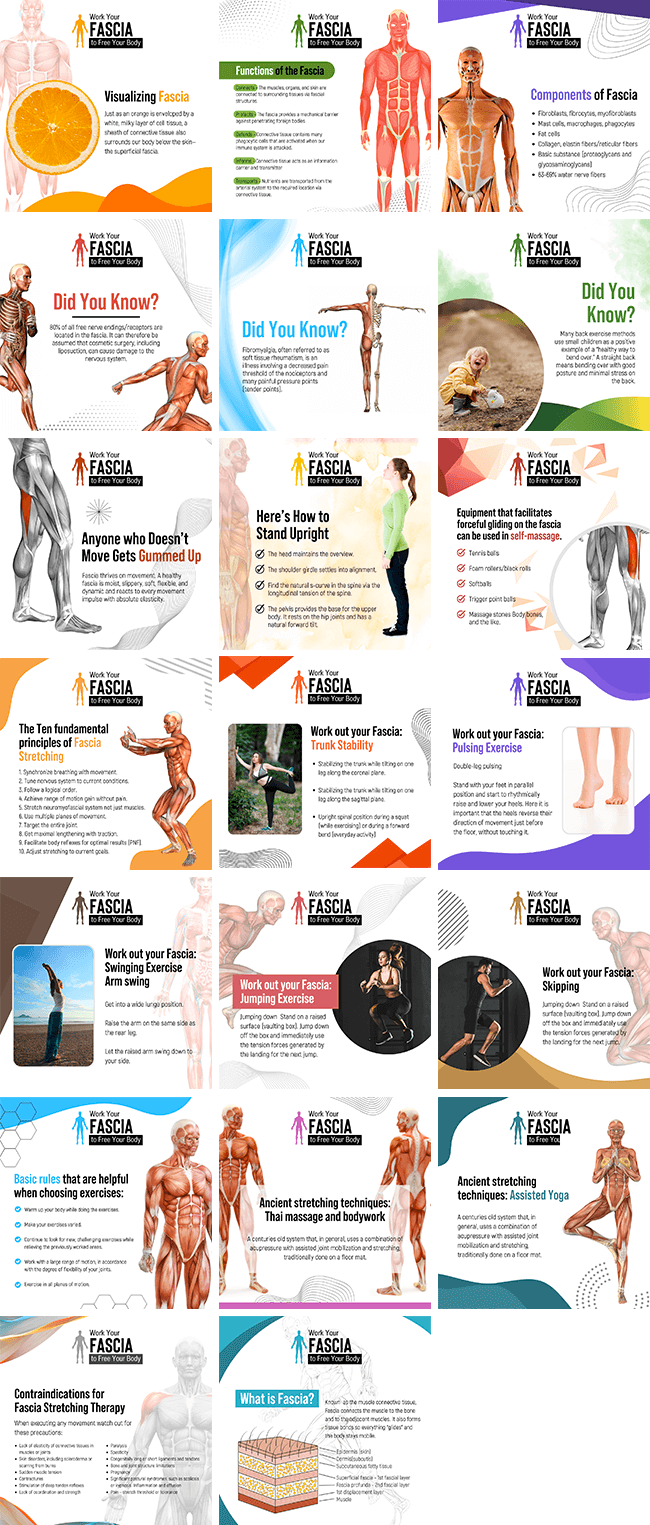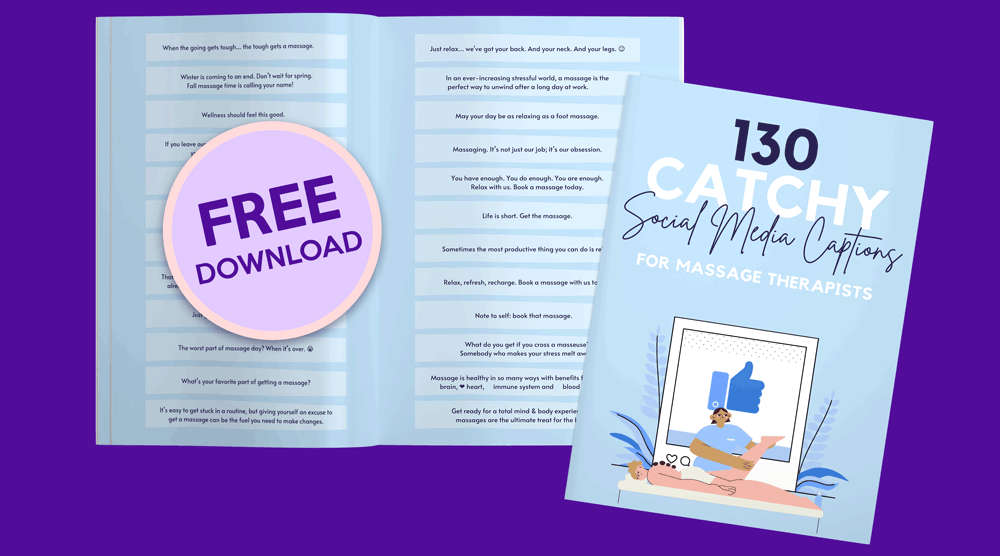Fascia is a band or sheet of connective tissue beneath the skin that attaches, stabilizes, and separates muscles and other internal organs. It’s like a web that supports and protects your entire body. Working your fascia through massage can help increase flexibility, improve muscle performance, and reduce pain. Sharing this information on social media is crucial because it can help followers understand the importance of fascia health for overall well-being. By learning about fascia massage therapy, they can take proactive steps towards better body care. This knowledge could significantly impact their lives by reducing discomfort and improving physical performance.
Inside The Bundle
BONUS 20 sample captions for you to share with your bundle!
BONUS Editable Canva Template!
The Work Your Fascia to Free Your Body includes 20 beautiful pieces of visual content:
Image Content
- Known as the muscle connective tissue, Fascia connects the muscle to the bone and to the adjacent muscles. It also forms tissue bonds so everything “glides” and the body stays mobile.
- Visualizing Fascia. Just as an orange is enveloped by a white, milky layer of cell tissue, a sheath of connective tissue also surrounds our body below the skin—the superficial fascia.
Functions of the Fascia.
Connects – The muscles, organs, and skin are connected to surrounding tissues via fascial structures. Protects – The fascia provides a mechanical barrier against penetrating foreign bodies Defends – Connective tissue contains many phagocytic cells that are activated when our immune system is attacked. Informs – Connective tissue acts as an information carrier and transmitter Transports – Nutrients are transported from the arterial system to the required location via connective tissue.
- Components of Fascia: Fibroblasts, fibrocytes, myofibroblasts Mast cells, macrophages, phagocytes Fat cells Collagen, elastin fibers/reticular fibers Basic substance (proteoglycans and glycosaminoglycans) 63-69% water nerve fibers.
- Did you know? 80% of all free nerve endings/receptors are located in the fascia. It can therefore be assumed that cosmetic surgery, including liposuction, can cause damage to the nervous system.
- Did you know? Fibromyalgia, often referred to as soft tissue rheumatism, is an illness involving a decreased pain threshold of the nociceptors and many painful pressure points (tender points).
- Did you know? Many back exercise methods use small children as a positive example of a “healthy way to bend over.” A straight back means bending over with good posture and minimal stress on the back.
- Anyone who Doesn’t Move Gets Gummed Up. Fascia thrives on movement. A healthy fascia is moist, slippery, soft, flexible, and dynamic and reacts to every movement impulse with absolute elasticity.
- Here’s How to Stand Upright. The head maintains the overview. The shoulder girdle settles into alignment. Find the natural s-curve in the spine via the longitudinal tension of the spine. The pelvis provides the base for the upper body. It rests on the hip joints and has a natural forward tilt.
- Equipment that facilitates forceful gliding on the fascia can be used in self-massage. Tennis balls Foam rollers/black rolls Softballs Trigger point balls Massage stones Body bones, and the like.
- The Ten Fundamental Principles of Fascia Stretching. 1. Synchronize breathing with movement. 2. Tune nervous system to current conditions. 3. Follow a logical order. 4. Achieve range of motion gain without pain. 5. Stretch neuromyofascial system, not just muscles. 6. Use multiple planes of movement. 7. Target the entire joint. 8. Get maximal lengthening with traction. 9. Facilitate body reflexes for optimal results (PNF). 10. Adjust stretching to current goals.
- Work out your Fascia: Trunk Stability. Stabilizing the trunk while tilting on one leg along the coronal plane. Stabilizing the trunk while tilting on one leg along the sagittal plane. Upright spinal position during a squat (while exercising) or during a forward bend (everyday activity)
- Work out your Fascia: Pulsing Exercise. Double-leg pulsing. Stand with your feet in parallel position and start to rhythmically raise and lower your heels. Here it is important that the heels reverse their direction of movement just before the floor, without touching it.
- Work out your Fascia: Swinging Exercise Arm swing. Get into a wide lunge position. Raise the arm on the same side as the rear leg. Let the raised arm swing down to your side.
- Work out your Fascia: Jumping Exercise. Jumping down Stand on a raised surface (vaulting box). Jump down off the box and immediately use the tension forces generated by the landing for the next jump.
- Work out your Fascia: Skipping. Jumping down Stand on a raised surface (vaulting box). Jump down off the box and immediately use the tension forces generated by the landing for the next jump.
- Basic rules that are helpful when choosing exercises: Warm up your body while doing the exercises. Make your exercises varied. Continue to look for new, challenging exercises while relieving the previously worked areas. Work with a large range of motion, in accordance with the degree of flexibility of your joints. Exercise in all planes of motion.
- Ancient stretching techniques: Thai massage and bodywork. A centuries old system that, in general, uses a combination of acupressure with assisted joint mobilization and stretching, traditionally done on a floor mat.
- Ancient stretching techniques: Assisted Yoga. A centuries old system that, in general, uses a combination of acupressure with assisted joint mobilization and stretching, traditionally done on a floor mat.
- Contraindications for Fascia Stretching Therapy. When executing any movement watch out for these precautions:
Lack of elasticity of connective tissues in muscles or joints Skin disorders, including scleroderma or scarring from burns Sudden muscle tension Contractures Stimulation of deep tendon reflexes Lack of coordination and strength.
Paralysis Spasticity Congenitally long or short ligaments and tendons Bone and joint structure limitations Pregnancy Significant postural syndromes, such as scoliosis or kyphosis Inflammation and effusion Pain – stretch threshold or tolerance
- Includes 20 ready-made Images
- All images are high resolution PNG
- Includes fully editable Canva template
- Includes 20 social media post captions
- Add your own branding!
Share this:
- Includes 20 ready-made Images
- All images are high resolution PNG
- Includes fully editable Canva template
- Includes 20 social media post captions
- Add your own branding!



